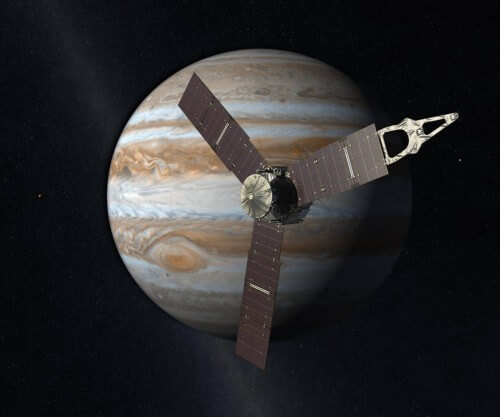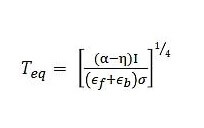The nearly twenty thousand cells installed on the spacecraft are arranged in three arrays about the size of a large tow truck carrying a tractor. In orbit around the Earth the solar panels generate 14 kilowatts of electricity, however, when the spacecraft entered its orbit around Jupiter, the panels would only manage to generate a paltry 400 watts

[Translation by Dr. Nachmani Moshe]
The Juno spacecraft, launched in early 2011, is equipped with an impressive solar array that manages to provide it with the energy it needs for a five-year journey into the vastness of space, even now, as it begins its 18-month sojourn around the largest planet in the solar system. , Jupiter. The American Space Agency (NASA) chose to supply energy to the spacecraft from a photovoltaic system due to a shortage of the radioactive element plutonium while combining very efficient solar cells and a specially structured array of panels.
The nearly twenty thousand cells installed on the spacecraft are arranged in three arrays about the size of a large tow truck carrying a tractor. In orbit around the Earth the solar panels generate 14 kilowatts of electricity, however, when the spacecraft entered its orbit around Jupiter, the panels would only manage to generate a paltry 400 watts. Unfortunately, the spacecraft's scientific instruments and computer are energy-intensive systems.
The image shows Juno's solar panels as the spacecraft approaches Jupiter. Juno has the largest array of solar panels NASA has ever operated, compared to any other mission except the International Space Station. The spacecraft includes three arrays of nine-meter-long solar panels, equipped with 18,698 individual solar cells. (Image courtesy of NASA/JPL-Caltech).
The great distance from the sun allows receiving a very low intensity of solar energy equal to a rate of only 4.1-3.4% of the amount that reaches the earth. And to add difficulties to problems in terms of supplying energy to the Juno spacecraft, the sun's rays operate in an environment of extremely low temperatures. Below is a calculation using the Stefan-Boltzmann law (a physical law that states that the radiation flux emitted by a black body is proportional to the fourth power of its temperature. The law is of great importance in astrophysics, because it helps to determine the absolute size of a star given its temperature, which can be found using Wien's law ) that allows the calculation of the amount of solar radiation converted to heat. The equilibrium temperature of a flat surface can be calculated using the Stefan-Boltzmann equation:

where α is the solar absorption coefficient; I is the radiation intensity; e is the front and rear thermal emission coefficient (under the assumption of emission from both sides); And sigma is the Stefan-Boltzmann constant equal to 5.67 x 10-8 W/m2K4. The intensity of the radiation decreases with the square of the distance from the sun.

10 תגובות
From 1969 there is no more interstellar travel. 47 years. I agree with you Lorem. A risk such as radioactive material that decays slowly can be overcome.
As for the reactor for larger space vehicle purposes. Aircraft carriers have been operating for 13 years with one uranium core. If you are thinking about a journey to Mars, why turn off the engines, and depend on the timings of meetings between Earth and Mars. A nuclear reactor can be activated at a certain moment. During the journey in the atmosphere it will be turned off. The materials will be distributed.
https://en.wikipedia.org/wiki/Stefan%E2%80%93Boltzmann_law
According to the attached link, the utilization of the boards is 28%. It should be remembered that the spacecraft was designed in 2003, and it is clear that the indicators have improved since then. On this site they claim that "we needed 50 square meters and divided it into three wings", a bit different from what appears on other sites, which is about 45%.
http://www.popsci.com/how-juno-broke-distance-record-for-solar-powered-spacecraft
To Lorem Ipsum. If the numbers are correct then each square meter gives about 200W. This is a very poor efficiency (in NASA terms). The numbers may not be correct since the boards in the spacecraft are more than 45% efficient with multi junction technology. Today's theories predict an efficiency that reaches 65% and more. Unfortunately, the application of the technology is extremely difficult, so you don't see them on the market yet. We are a group of scientists working on the new technology and when there are results we will publish. The formula of the Stefan-Boltzmann law (a physical law stating that the radiation flux emitted by a blackbody is proportional to the fourth power of its temperature) does not belong here. It is a parameter of the intensity of the radiation and not of the properties of the solar panel. The solar panel has other calculations.
You don't need an entire nuclear reactor for such a spaceship. What is needed is called RTG, which is nothing more than a small piece of plutonium 238, which decays and produces heat that turns into electrical energy. The problem: NASA lacks some of this material, and all the technological idiots also go into hysteria when they hear that a "nuclear reactor" is about to be launched several thousand kilometers outside the atmosphere. So NASA put these huge solar collectors on the spacecraft, cost the launch God knows how many millions of dollars, put the spacecraft on a strict diet of 400 watts, reduced the technological equipment they loaded on it because of this and because of the additional weight of the collectors and set off.
https://he.wikipedia.org/wiki/%D7%92%D7%A0%D7%A8%D7%98%D7%95%D7%A8_%D7%A8%D7%93%D7%99%D7%95%D7%90%D7%99%D7%96%D7%95%D7%98%D7%95%D7%A4%D7%99_%D7%AA%D7%A8%D7%9E%D7%95%D7%90%D7%9C%D7%A7%D7%98%D7%A8%D7%99
I know critical mass is required but there is such a small reactor concept.
Why not a small nuclear reactor?
If the fear is that a failure will happen in the atmosphere, a reactor that goes into operation not from the start is possible.
I understand that the control of a nuclear reactor is very complex and the chance of failure is great. But then the failure is in space. There is no danger to the earth in it.
Juno has three solar panels that measure 2.7 meters by 8.9 meters each, and there is no need to get involved (as the Americans like) with a semi-trailer carrying a tractor (or vice versa) or areas of soccer fields and volumes of squash halls.
https://www.youtube.com/watch?v=IL_tU5zn6u0
In general, a solar array is really impractical at such distances from the sun and it becomes completely impractical at distances a little further from the sun, such as near Saturn or even Oron and Rahab. Even around Mars or on its surface, solar collectors have quite a few problems and the solution is found in a completely different field, which surprisingly can also be applied on Mars, but mainly here on Earth:
https://www.youtube.com/watch?v=0BybPPIMuQQ
A little long, but worth the investment.
I did not understand some things in the article. In the vicinity of Zedek the panels produce 400 watts. The equipment consumes a lot of energy. Does it mean that it consumes more than 400 watts and does NASA have some trick to overcome the shortage? Or are they balanced in terms of consumption versus electricity supply? I also didn't understand the Boltzmann formula (which I don't know). It is clear that those who are 5 times farther from the light source will see it 5 times weaker in the square. That is, about 4% (5 is astronomical units). Is there another parameter related to the temperature of the panels? Is this what the Baltzmann formula deals with?
What is a "large tow truck carrying a tractor"? Do you mean TRACTOR TRAILER? - In Hebrew it is called "semi-trailer" and maybe the academy has a name?
The whole black body radiation thing has nothing to do with solar collectors. Even without any formula it is possible to explain that far from the sun it is simply colder than here. And it is not clear to me if a low temperature has an effect on the solar collectors, apart from mechanical problems.